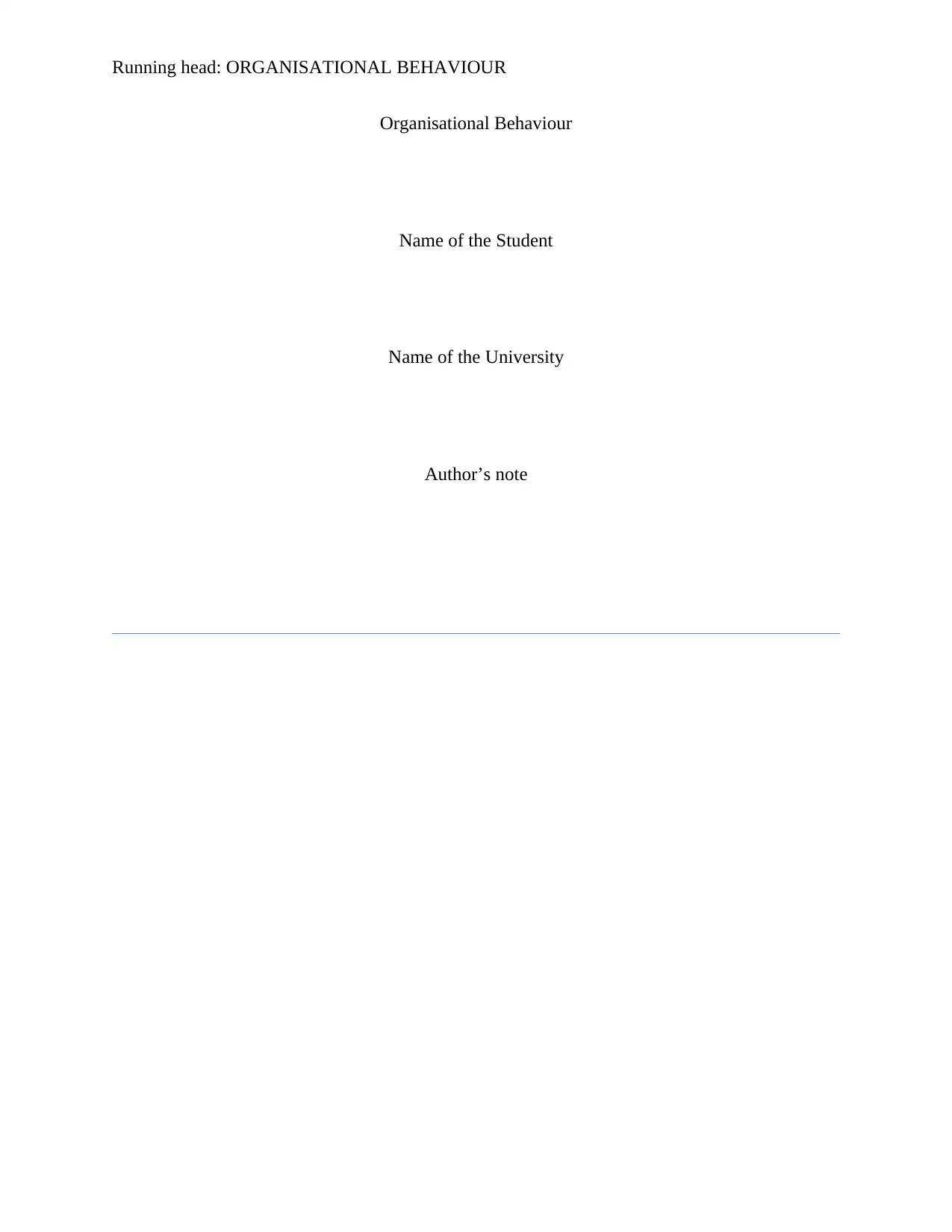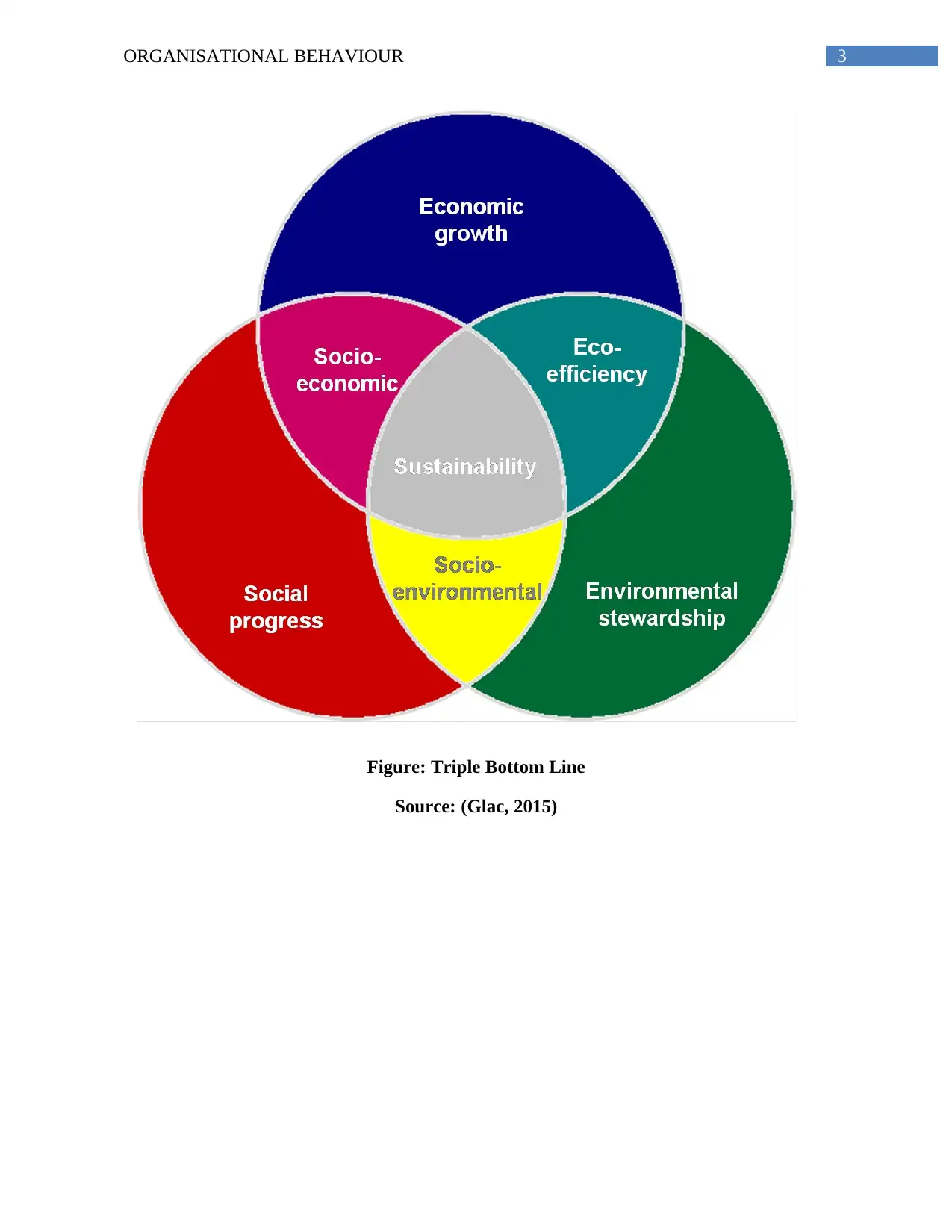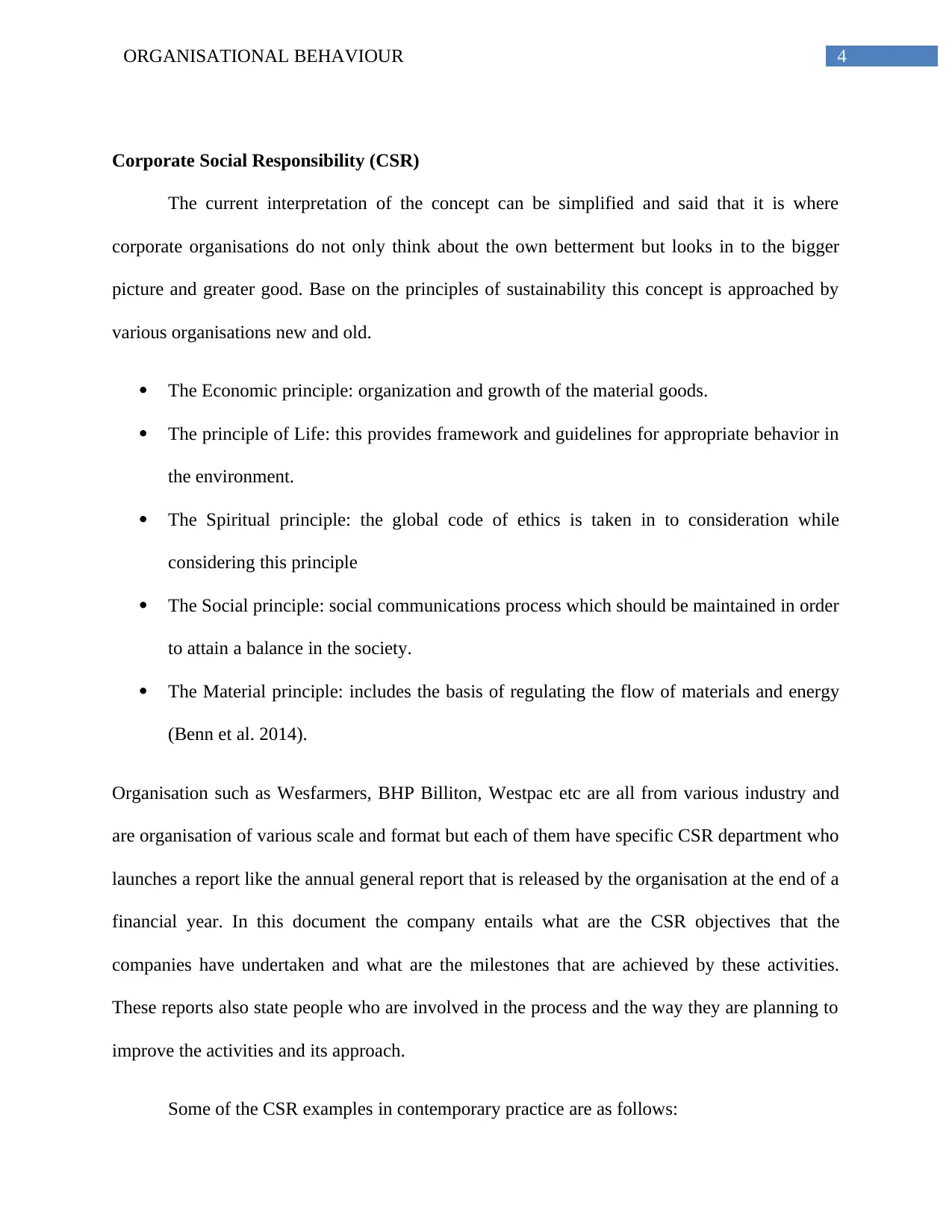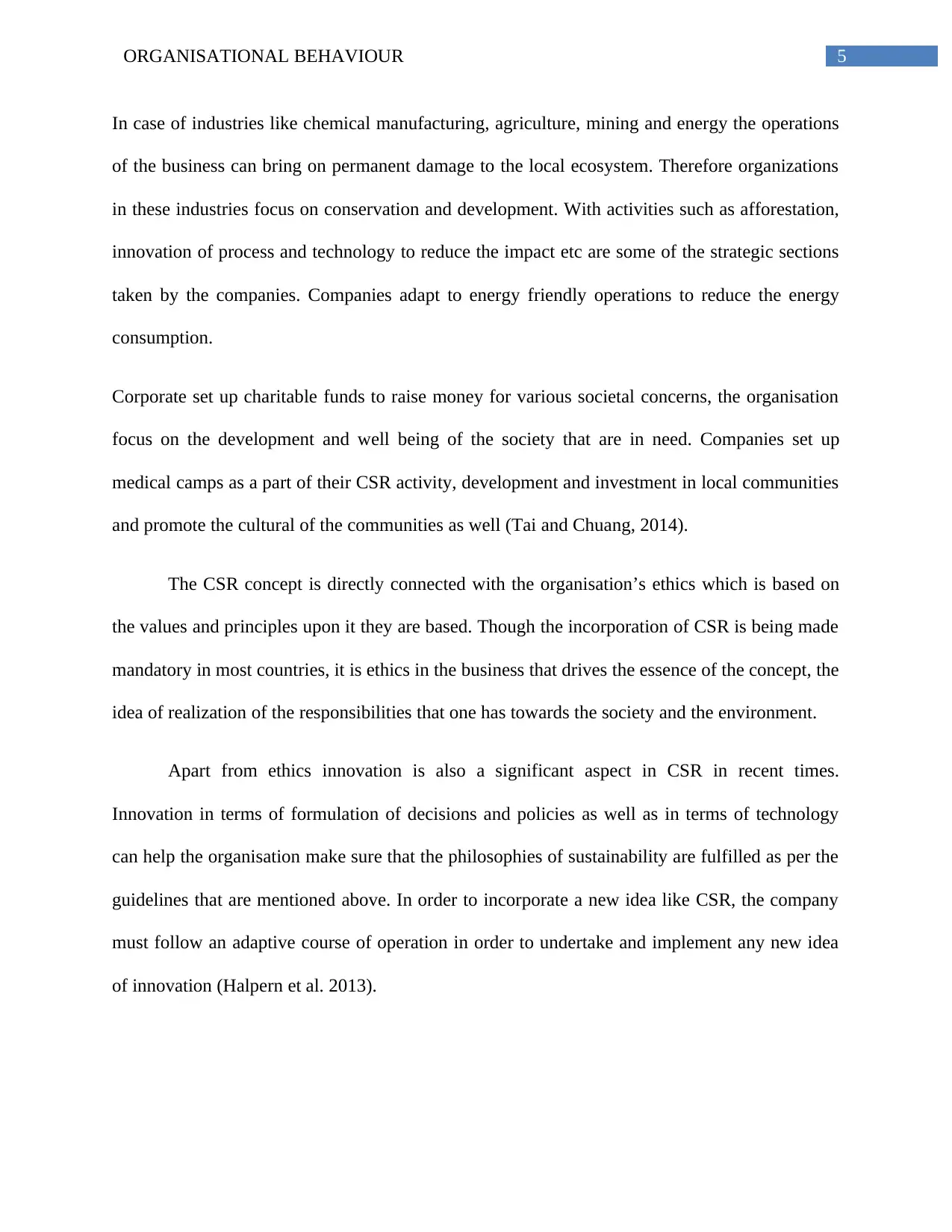Essay on Corporate Social Responsibility in Organisational Behaviour
VerifiedAdded on 2023/06/13
|9
|1883
|409
Essay
AI Summary
This essay provides a comprehensive overview of Corporate Social Responsibility (CSR) and its current interpretation within organisational behaviour. It begins by defining sustainability and its connection to CSR, highlighting the shift from traditional business models to those incorporating social, environmental, and economic benefits for all stakeholders. The essay discusses the concept of the triple bottom line (People, Planet, and Profit) and its importance in balancing these aspects for sustainable growth. It further elaborates on the principles of CSR, including economic, life, spiritual, social, and material principles, citing examples of companies like Wesfarmers and BHP Billiton. The essay also touches upon the role of ethics and innovation in driving CSR initiatives. Finally, it references the United Nations' ten principles of the Global Compact as guidelines for organisations in developing their CSR action plans, concluding that organisations are increasingly aware of their responsibilities towards environmental protection and societal well-being.

Running head: ORGANISATIONAL BEHAVIOUR
Organisational Behaviour
Name of the Student
Name of the University
Author’s note
Organisational Behaviour
Name of the Student
Name of the University
Author’s note
Paraphrase This Document
Need a fresh take? Get an instant paraphrase of this document with our AI Paraphraser

1ORGANISATIONAL BEHAVIOUR
Current interpretation of Corporate Social Responsibility
Introduction
Sustainability can be defined as the process of growth that is focused not only on the
monetary and fiscal limitations but is also focused towards the development of the environment
and the society. The concept was introduced in 1985 by Brundtland Commission of the United
Nations (Brundtland 1985). Sustainable development is the acknowledgment of organisations as
well as individuals of the duties they have towards the environment and the society (Benn et al.
2014). The resources that are incorporated in the process of development depend upon the
environment or the society therefore it becomes the duty of all to monitor the well being of the
foundation of these resources. Based on this concept the approach of Corporate Social
Responsibility (CSR) is built. It is the actions that is taken by a Corpoate entty to put together
sustainability into the functions of the company, effective governance and the style of leadership
of the organisation. Corporate Social Responsibility functions revolve around the social,
environmental and economic benefits to all the stakeholders of the organisation (Tai and Chuang
2014). It is a contrast to the traditional business model as it does not focus on the growth and
development of the business alone, slowly organisations all over the world has adapted to this
business model, several rules and regulations based on the industry of operation have been
developed by authoritative bodies like government and United Nations etc.
The concept of triple bottom line
The concept explains why it is important to have equal focus on the three Ps: Price,
Planet and People. Triple bottom line was coined by John Elkington in 1994, hence it can be said
Current interpretation of Corporate Social Responsibility
Introduction
Sustainability can be defined as the process of growth that is focused not only on the
monetary and fiscal limitations but is also focused towards the development of the environment
and the society. The concept was introduced in 1985 by Brundtland Commission of the United
Nations (Brundtland 1985). Sustainable development is the acknowledgment of organisations as
well as individuals of the duties they have towards the environment and the society (Benn et al.
2014). The resources that are incorporated in the process of development depend upon the
environment or the society therefore it becomes the duty of all to monitor the well being of the
foundation of these resources. Based on this concept the approach of Corporate Social
Responsibility (CSR) is built. It is the actions that is taken by a Corpoate entty to put together
sustainability into the functions of the company, effective governance and the style of leadership
of the organisation. Corporate Social Responsibility functions revolve around the social,
environmental and economic benefits to all the stakeholders of the organisation (Tai and Chuang
2014). It is a contrast to the traditional business model as it does not focus on the growth and
development of the business alone, slowly organisations all over the world has adapted to this
business model, several rules and regulations based on the industry of operation have been
developed by authoritative bodies like government and United Nations etc.
The concept of triple bottom line
The concept explains why it is important to have equal focus on the three Ps: Price,
Planet and People. Triple bottom line was coined by John Elkington in 1994, hence it can be said

2ORGANISATIONAL BEHAVIOUR
that the concept is contemporary; Elkington states that corporate should not have one particular
area of significance while planning for the growth and development of the organisation (Glac,
2015). He emphasizes on the importance of all the three aspects that are aforementioned. The
theory sets a juxtaposing suggestion with the traditional business model that the management of
the organisation previously followed. According to Milne and Gray (2013), the traditional
business model, the variables and the actions of the organisation revolved around growth and
development of the company itself, which means financial growth of the company. On the other
hand, any other factors that call for deviation from the above mentioned objective were identified
as a weight on the organisation as well as consider as a liability because the organisation had to
invest in these aspects which take away from the revenue and the profit. The thought of the
future generation is what initiates the process of being sustainable. Corporate organisation
evaluates the investment in a venture or action based on the return on investment that could add
to the development of the organisation. Sustainable ventures are mostly supported on thorough
research investment as well as the installation of new technology. It also needs capital
investment therefore the companies are anxious because these strategies do not guarantee
affirmative return on investment (Milne and Gray 2013). According to Tatari et al.(2015), The
triple bottom line concept is fundament of CSR, an organisation adapts to the triple bottom line
concept by incorporating CSR activities in the day to day operations of the business. For
example: heavy industries like oil and gas, metal and mining etc have CSR activities planned
according to the adverse impact the organisation have on the environment as well as on the
society.
that the concept is contemporary; Elkington states that corporate should not have one particular
area of significance while planning for the growth and development of the organisation (Glac,
2015). He emphasizes on the importance of all the three aspects that are aforementioned. The
theory sets a juxtaposing suggestion with the traditional business model that the management of
the organisation previously followed. According to Milne and Gray (2013), the traditional
business model, the variables and the actions of the organisation revolved around growth and
development of the company itself, which means financial growth of the company. On the other
hand, any other factors that call for deviation from the above mentioned objective were identified
as a weight on the organisation as well as consider as a liability because the organisation had to
invest in these aspects which take away from the revenue and the profit. The thought of the
future generation is what initiates the process of being sustainable. Corporate organisation
evaluates the investment in a venture or action based on the return on investment that could add
to the development of the organisation. Sustainable ventures are mostly supported on thorough
research investment as well as the installation of new technology. It also needs capital
investment therefore the companies are anxious because these strategies do not guarantee
affirmative return on investment (Milne and Gray 2013). According to Tatari et al.(2015), The
triple bottom line concept is fundament of CSR, an organisation adapts to the triple bottom line
concept by incorporating CSR activities in the day to day operations of the business. For
example: heavy industries like oil and gas, metal and mining etc have CSR activities planned
according to the adverse impact the organisation have on the environment as well as on the
society.
⊘ This is a preview!⊘
Do you want full access?
Subscribe today to unlock all pages.

Trusted by 1+ million students worldwide

3ORGANISATIONAL BEHAVIOUR
Figure: Triple Bottom Line
Source: (Glac, 2015)
Figure: Triple Bottom Line
Source: (Glac, 2015)
Paraphrase This Document
Need a fresh take? Get an instant paraphrase of this document with our AI Paraphraser

4ORGANISATIONAL BEHAVIOUR
Corporate Social Responsibility (CSR)
The current interpretation of the concept can be simplified and said that it is where
corporate organisations do not only think about the own betterment but looks in to the bigger
picture and greater good. Base on the principles of sustainability this concept is approached by
various organisations new and old.
The Economic principle: organization and growth of the material goods.
The principle of Life: this provides framework and guidelines for appropriate behavior in
the environment.
The Spiritual principle: the global code of ethics is taken in to consideration while
considering this principle
The Social principle: social communications process which should be maintained in order
to attain a balance in the society.
The Material principle: includes the basis of regulating the flow of materials and energy
(Benn et al. 2014).
Organisation such as Wesfarmers, BHP Billiton, Westpac etc are all from various industry and
are organisation of various scale and format but each of them have specific CSR department who
launches a report like the annual general report that is released by the organisation at the end of a
financial year. In this document the company entails what are the CSR objectives that the
companies have undertaken and what are the milestones that are achieved by these activities.
These reports also state people who are involved in the process and the way they are planning to
improve the activities and its approach.
Some of the CSR examples in contemporary practice are as follows:
Corporate Social Responsibility (CSR)
The current interpretation of the concept can be simplified and said that it is where
corporate organisations do not only think about the own betterment but looks in to the bigger
picture and greater good. Base on the principles of sustainability this concept is approached by
various organisations new and old.
The Economic principle: organization and growth of the material goods.
The principle of Life: this provides framework and guidelines for appropriate behavior in
the environment.
The Spiritual principle: the global code of ethics is taken in to consideration while
considering this principle
The Social principle: social communications process which should be maintained in order
to attain a balance in the society.
The Material principle: includes the basis of regulating the flow of materials and energy
(Benn et al. 2014).
Organisation such as Wesfarmers, BHP Billiton, Westpac etc are all from various industry and
are organisation of various scale and format but each of them have specific CSR department who
launches a report like the annual general report that is released by the organisation at the end of a
financial year. In this document the company entails what are the CSR objectives that the
companies have undertaken and what are the milestones that are achieved by these activities.
These reports also state people who are involved in the process and the way they are planning to
improve the activities and its approach.
Some of the CSR examples in contemporary practice are as follows:

5ORGANISATIONAL BEHAVIOUR
In case of industries like chemical manufacturing, agriculture, mining and energy the operations
of the business can bring on permanent damage to the local ecosystem. Therefore organizations
in these industries focus on conservation and development. With activities such as afforestation,
innovation of process and technology to reduce the impact etc are some of the strategic sections
taken by the companies. Companies adapt to energy friendly operations to reduce the energy
consumption.
Corporate set up charitable funds to raise money for various societal concerns, the organisation
focus on the development and well being of the society that are in need. Companies set up
medical camps as a part of their CSR activity, development and investment in local communities
and promote the cultural of the communities as well (Tai and Chuang, 2014).
The CSR concept is directly connected with the organisation’s ethics which is based on
the values and principles upon it they are based. Though the incorporation of CSR is being made
mandatory in most countries, it is ethics in the business that drives the essence of the concept, the
idea of realization of the responsibilities that one has towards the society and the environment.
Apart from ethics innovation is also a significant aspect in CSR in recent times.
Innovation in terms of formulation of decisions and policies as well as in terms of technology
can help the organisation make sure that the philosophies of sustainability are fulfilled as per the
guidelines that are mentioned above. In order to incorporate a new idea like CSR, the company
must follow an adaptive course of operation in order to undertake and implement any new idea
of innovation (Halpern et al. 2013).
In case of industries like chemical manufacturing, agriculture, mining and energy the operations
of the business can bring on permanent damage to the local ecosystem. Therefore organizations
in these industries focus on conservation and development. With activities such as afforestation,
innovation of process and technology to reduce the impact etc are some of the strategic sections
taken by the companies. Companies adapt to energy friendly operations to reduce the energy
consumption.
Corporate set up charitable funds to raise money for various societal concerns, the organisation
focus on the development and well being of the society that are in need. Companies set up
medical camps as a part of their CSR activity, development and investment in local communities
and promote the cultural of the communities as well (Tai and Chuang, 2014).
The CSR concept is directly connected with the organisation’s ethics which is based on
the values and principles upon it they are based. Though the incorporation of CSR is being made
mandatory in most countries, it is ethics in the business that drives the essence of the concept, the
idea of realization of the responsibilities that one has towards the society and the environment.
Apart from ethics innovation is also a significant aspect in CSR in recent times.
Innovation in terms of formulation of decisions and policies as well as in terms of technology
can help the organisation make sure that the philosophies of sustainability are fulfilled as per the
guidelines that are mentioned above. In order to incorporate a new idea like CSR, the company
must follow an adaptive course of operation in order to undertake and implement any new idea
of innovation (Halpern et al. 2013).
⊘ This is a preview!⊘
Do you want full access?
Subscribe today to unlock all pages.

Trusted by 1+ million students worldwide

6ORGANISATIONAL BEHAVIOUR
Globally accepted principles of Sustainability
United nations have set four areas which are of concern in sustainability actions: these
human resource, environment, anti-corruption and environment. There are ten principles that are
explained in the UN Global Compact. These principles can be used as guidelines by organisation
to develop their action plan and manage their CSR activities. Today organisations have separate
CSR department who just looks after the management of these aspects. The principles stated by
the UN are as follows:
• Internationally accepted human rights guidelines and rules have to be incorporate in
the operations of the busienss
• Exploitation of human resources is a is a punishable crime
• The liberty of organization and the efficient recognition of the right of combined
negotiation should be employ by the organisations
• Forced or compulsory labor is also punishable offence
• There should be encouragement in the organisation in terms of work ethics and
situations like abolition of child labor
• There should be no unfair ways of employment and occupation growth in the
company
• preventative measure must be taken by business companies that deal with the
environment depletion
• The organisation must support and promote environmental accountability
• Sustainable innovation and development should be encouraged in the organization
• Corruption is explained by two aspects extortion and bribery organisation must avoid
these at every step (The Ten Principles of the UN Global Compact 2017)
Globally accepted principles of Sustainability
United nations have set four areas which are of concern in sustainability actions: these
human resource, environment, anti-corruption and environment. There are ten principles that are
explained in the UN Global Compact. These principles can be used as guidelines by organisation
to develop their action plan and manage their CSR activities. Today organisations have separate
CSR department who just looks after the management of these aspects. The principles stated by
the UN are as follows:
• Internationally accepted human rights guidelines and rules have to be incorporate in
the operations of the busienss
• Exploitation of human resources is a is a punishable crime
• The liberty of organization and the efficient recognition of the right of combined
negotiation should be employ by the organisations
• Forced or compulsory labor is also punishable offence
• There should be encouragement in the organisation in terms of work ethics and
situations like abolition of child labor
• There should be no unfair ways of employment and occupation growth in the
company
• preventative measure must be taken by business companies that deal with the
environment depletion
• The organisation must support and promote environmental accountability
• Sustainable innovation and development should be encouraged in the organization
• Corruption is explained by two aspects extortion and bribery organisation must avoid
these at every step (The Ten Principles of the UN Global Compact 2017)
Paraphrase This Document
Need a fresh take? Get an instant paraphrase of this document with our AI Paraphraser

7ORGANISATIONAL BEHAVIOUR
Conclusion
It can be concluded form the above discussion that the organisations all over the world
are increasingly becoming aware of the depleting environmental situation as well as the
responsibility they have towards ensuring societal well being, large corporations like
Wesfarmers, Westpac, BHP Billiton, Microsoft, Google etc are setting benchmarks in their CSR
approaches encouraging the new organisations to do the same.
Conclusion
It can be concluded form the above discussion that the organisations all over the world
are increasingly becoming aware of the depleting environmental situation as well as the
responsibility they have towards ensuring societal well being, large corporations like
Wesfarmers, Westpac, BHP Billiton, Microsoft, Google etc are setting benchmarks in their CSR
approaches encouraging the new organisations to do the same.

8ORGANISATIONAL BEHAVIOUR
Reference list:
Benn, S., Dunphy, D., & Griffiths, A., 2014. Organizational change for corporate sustainability.
Routledge.
Brundtland, G.H., 1985. World commission on environment and development. Environmental
policy and law, 14(1), pp.26-30.
Glac, K., 2015. Triple Bottom Line. Wiley Encyclopedia of Management.
Halpern, B. S., Klein, C. J., Brown, C. J., Beger, M., Grantham, H. S., Mangubhai,
S., ...&Possingham, H. P., 2013. Achieving the triple bottom line in the face of inherent trade-
offs among social equity, economic return, and conservation. Proceedings of the National
Academy of Sciences, 110(15), 6229-6234.
Milne, M.J. and Gray, R., 2013. W (h) ither ecology? The triple bottom line, the global reporting
initiative, and corporate sustainability reporting. Journal of business ethics, 118(1), pp.13-29.
Schrempf-Stirling, J., Palazzo, G. and Phillips, R.A., 2016. Historic corporate social
responsibility. Academy of Management Review, 41(4), pp.700-719.
Tai, F.M. and Chuang, S.H., 2014. Corporate social responsibility. Ibusiness, 6(03), p.117.
Tatari, O., Kucukvar, M. and Onat, N.C., 2015, February. Towards a Triple Bottom Line Life
Cycle Sustainability Assessment of Buildings. In Science for Sustainable Construction and
Manufacturing Workshop Volume I. Position Papers and Findings (p. 226).
The Ten Principles of the UN Global Compact., 2017. unglobalcompact.org. Retrieved 30 April
2018, from https://www.unglobalcompact.org/what-is-gc/mission/principles
Reference list:
Benn, S., Dunphy, D., & Griffiths, A., 2014. Organizational change for corporate sustainability.
Routledge.
Brundtland, G.H., 1985. World commission on environment and development. Environmental
policy and law, 14(1), pp.26-30.
Glac, K., 2015. Triple Bottom Line. Wiley Encyclopedia of Management.
Halpern, B. S., Klein, C. J., Brown, C. J., Beger, M., Grantham, H. S., Mangubhai,
S., ...&Possingham, H. P., 2013. Achieving the triple bottom line in the face of inherent trade-
offs among social equity, economic return, and conservation. Proceedings of the National
Academy of Sciences, 110(15), 6229-6234.
Milne, M.J. and Gray, R., 2013. W (h) ither ecology? The triple bottom line, the global reporting
initiative, and corporate sustainability reporting. Journal of business ethics, 118(1), pp.13-29.
Schrempf-Stirling, J., Palazzo, G. and Phillips, R.A., 2016. Historic corporate social
responsibility. Academy of Management Review, 41(4), pp.700-719.
Tai, F.M. and Chuang, S.H., 2014. Corporate social responsibility. Ibusiness, 6(03), p.117.
Tatari, O., Kucukvar, M. and Onat, N.C., 2015, February. Towards a Triple Bottom Line Life
Cycle Sustainability Assessment of Buildings. In Science for Sustainable Construction and
Manufacturing Workshop Volume I. Position Papers and Findings (p. 226).
The Ten Principles of the UN Global Compact., 2017. unglobalcompact.org. Retrieved 30 April
2018, from https://www.unglobalcompact.org/what-is-gc/mission/principles
⊘ This is a preview!⊘
Do you want full access?
Subscribe today to unlock all pages.

Trusted by 1+ million students worldwide
1 out of 9
Related Documents
Your All-in-One AI-Powered Toolkit for Academic Success.
+13062052269
info@desklib.com
Available 24*7 on WhatsApp / Email
![[object Object]](/_next/static/media/star-bottom.7253800d.svg)
Unlock your academic potential
Copyright © 2020–2025 A2Z Services. All Rights Reserved. Developed and managed by ZUCOL.



